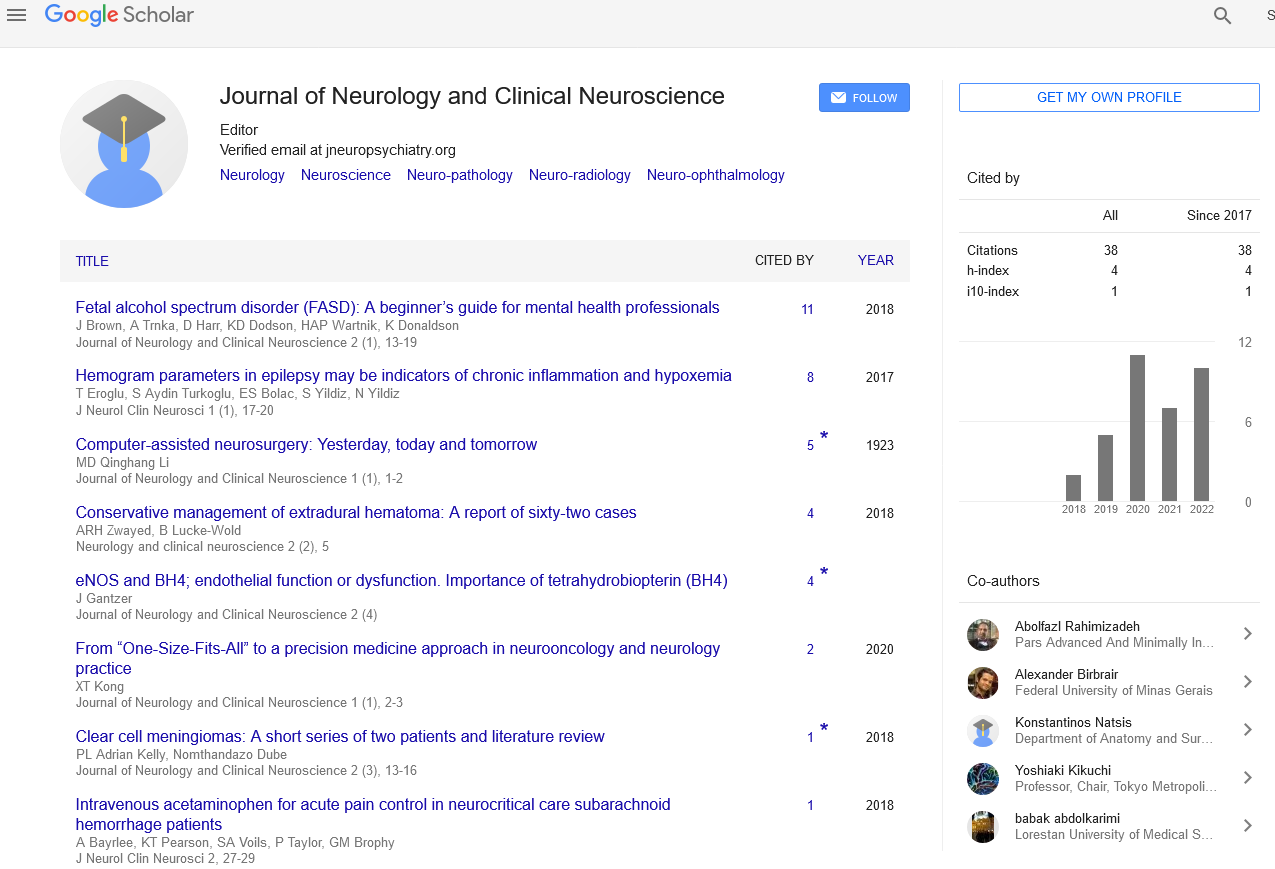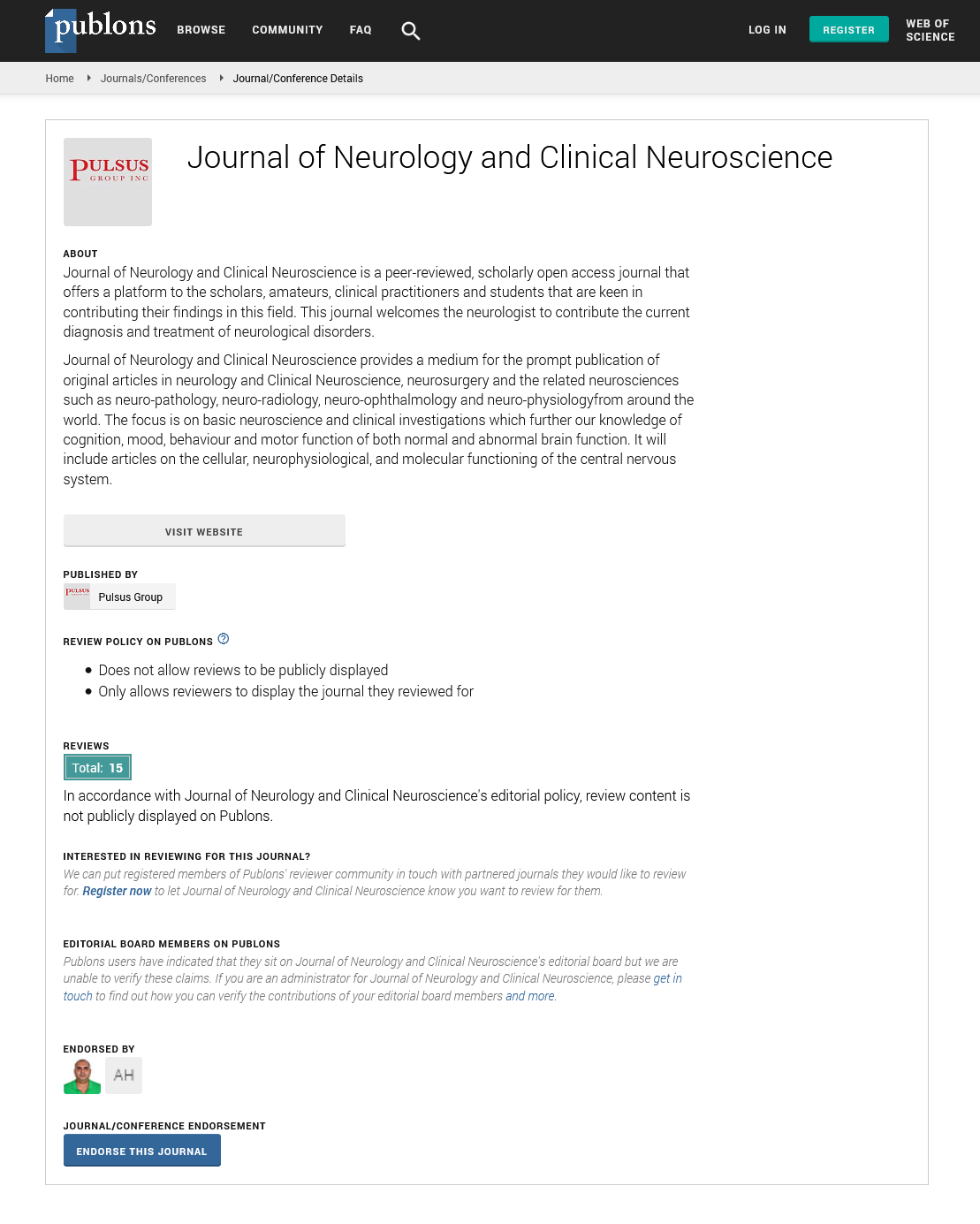Multiple sclerosis A disabling disease
Received: 18-Feb-2022, Manuscript No. PULJNCN-22-3925; Editor assigned: 21-Feb-2022, Pre QC No. PULJNCN-22-3925(PQ); Reviewed: 07-Mar-2022 QC No. PULJNCN-22-3925; Revised: 11-Mar-2022, Manuscript No. PULJNCN-22-3925(R); Published: 18-Mar-2022
Citation: Chandra S. Multiple sclerosis-A disabling disease. J Neurol Clin Neurosci. 2022;6(3):1
This open-access article is distributed under the terms of the Creative Commons Attribution Non-Commercial License (CC BY-NC) (http://creativecommons.org/licenses/by-nc/4.0/), which permits reuse, distribution and reproduction of the article, provided that the original work is properly cited and the reuse is restricted to noncommercial purposes. For commercial reuse, contact reprints@pulsus.com
Commentary
The most prevalent demyelinating disorder is Multiple Sclerosis (MS), also known as encephalomyelitis disseminate, in which the insulating coverings of nerve cells in the brain and spinal cord are disrupted. This disruption impairs the nervous system's ability to transfer impulses, leading to several of signs and symptoms, including physical, mental, and eventually psychiatric disorders. Double vision, blindness in one eye, muscle weakness, and difficulty with sensation or coordination are all possible symptoms. It comes in many different forms, with new symptoms emerging in solitary attacks (relapsing forms) or gradually over time (progressive forms). Symptoms may go unnoticed and untreated between attacks, but prolonged neurological damage is usual, especially as the condition worsens.
Multiple sclerosis has no permanent cure. Treatments strive to improve functions following an attack even while minimizing future attacks. While Multiple sclerosis medications are moderately effective, they can cause adverse effects and be poorly tolerated. People's ability to function can be enhanced with physical treatment and occupational therapy. Despite the lack of evidence of effectiveness, many people seek alternative treatments.
Long-term outcomes are difficult to predict; positive benefits are more prevalent in females, those who develop the illness early in life, those that have a relapsing condition, and those who have had very few attacks initially. The affected population's life expectancy is five to ten years lower than the unaffected population's.
Signs and symptoms
A person with Multiple sclerosis can encounter virtually any neurological symptom or condition, the most frequent of which are autonomic, ocular, motor, and sensory issues. Loss of sensitivity or changes in sensation such as itching, pins and needles, or numbness, muscle weakness, blurred vision, very pronounced reflexes, muscle spasms, or difficulty moving; difficulties with coordination and balance; problems with speech or swallowing, visual problems (nystagmus, optic neuritis, or double vision), feeling tired, acute bronchitis.
Causes
Multiple sclerosis has no definite etiology; however it is believed to be caused by a variety of genetic and environmental factors, such as infectious agents. Theories aim to synthesise data into feasible hypotheses, but none has proven conclusive. While there are several environmental risk factors, some of which are partially adjustable, further research is needed to see if eliminating all can prevent Multiple sclerosis.
Pathophysiology
The development of lesions in the central nervous system (also known as plaques), inflammation, and the destruction of myelin sheaths of neurons are the three basic characteristics of Multiple sclerosis. These enhance the experience in a complex and least understood way to cause nerve tissue destruction and, as a result, illness signs and symptoms.
Lesions
The scars that develop in the neurological system are referred to as multiple sclerosis. The white matter of the optic nerve, brain stem, basal ganglia, and spinal cord, as well as white matter tracts adjacent to the lateral ventricles, are by far the most typically affected areas. White matter cells are responsible for transmitting signals between grey matter processing areas and the rest of the body. Peripheral nervous system is rarely involved.
Inflammation
Inflammation is yet another symptom of the disease, in addition to demyelination. T cells, a cd4 cells that plays a key role in the body's resistance, are accountable for the inflammatory process, according to an immunological explanation. Disruptions in the blood–brain barrier allow Tlymphocytes to reach the brain. T-cells detect myelin as foreign and attack it, hence why these are also termed as "auto-reactive lymphocytes."
Blood–brain barrier
The Blood Brain Barrier (BBB) is a capillary system component that prohibits T lymphocytes from entering the central nervous system. It may become permeable to these cells as a result of a virus or bacterial infection. T cells may remain trapped inside the brain after it has healed itself, usually after the infection has disappeared. Gadolinium cannot penetrate a normal BBB, hence BBB breakdowns are visualized using gadolinium-enhanced MRI.
Diagnosis
Multiple sclerosis is usually diagnosed based on the signs and symptoms that are present, as well as supporting medical imaging and laboratory testing. It's tough to determine, especially early on, because the signs and symptoms can be identical to those of other medical conditions. One of the most common diagnostic tools is the MRI. Demyelination can be detected on Magnetic Resonance Imaging (MRI) of the brain and spine (lesions or plaques). Gadolinium can be administered intravenously as a contrast agent to highlight active plaques and, by demolishing them, confirm the existence of earlier lesions which are not associated with symptoms at the time of testing.





